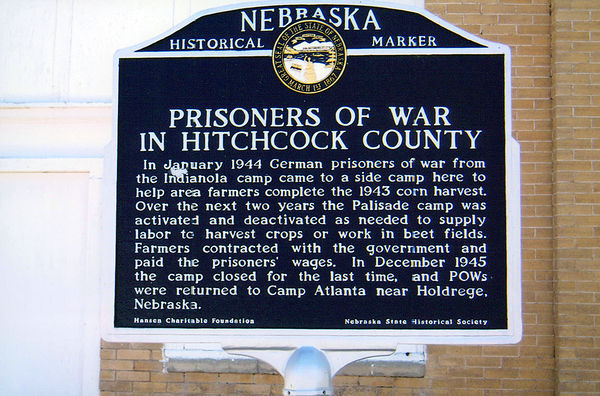Nebraska Historical Marker: Prisoners of War in Hitchcock County
Location
Rural Nebraska 25A, Palisade, Hitchcock County, Nebraska
View this marker's location 40.350322, -101.1075
View a map of all Nebraska historical markers, Browse Historical Marker Map
Marker Text
In January 1944 German prisoners of war from the Indianola camp came to a side camp here to help area farmers complete the 1943 corn harvest. Over the next two years the Palisade camp was activated and deactivated as needed to supply labor to harvest crops or work in beet fields. Farmers contracted with the government and paid the prisoners' wages. In December 1945 the camp closed for the last time, and POWs were returned to Camp Atlanta near Holdrege, Nebraska.
Further Information
During World War II, a number of Axis prisoners of war were held at camps in Nebraska. Some of these prisoners resided at a branch camp in Palisade.
The Indianola POW Camp A prisoner of war (POW) camp was built near Indianola during World War II. The camp was established in 1943 to hold prisoners and have them help with local labor projects. In May of 1944, the camp was designated as a branch camp of the Atlanta POW camp but was returned to full-camp status in September. The camp’s new mission was to hold pro-Nazi officers so they could not influence their men. Some of these officers were possibly war criminals. Prisoners at POW camps were allowed to work for a wage in non-war-related industries. Most Nebraska prisoners worked in agriculture. To reduce transportation costs, smaller branch camps were established in surrounding communities. One branch camp of the Indianola camp was established in Palisade.
The Palisade Camp About 300 POWs were held at the Palisade camp. The camp consisted of several local buildings repurposed for holding prisoners and guards. Prisoners came from both the Indianola and Atlanta camps. They worked with local farmers in the fields from 8 in the morning to 7 at night. At first, guards always accompanied them, but later guards became unnecessary. Farmers and prisoners generally had very good relationships, and escape attempts were futile since they were so far inland escapees would have little hope of avoiding recapture. Two men, not realizing how far away they were from the coasts, tried to escape but only got to a nearby farm before they were found and returned to camp. There were 151 local farms that used labor from the Palisade camp. The camp was deactivated in December of 1945. All the prisoners there were moved to the Atlanta camp.
Bibliography
Discoe, Connie Jo. “The prisoners among us -- How enemies worked together during World War II.” McCook Daily Gazette. December 8, 2006.
Marker program
See Nebraska Historical Marker Program for more information.
